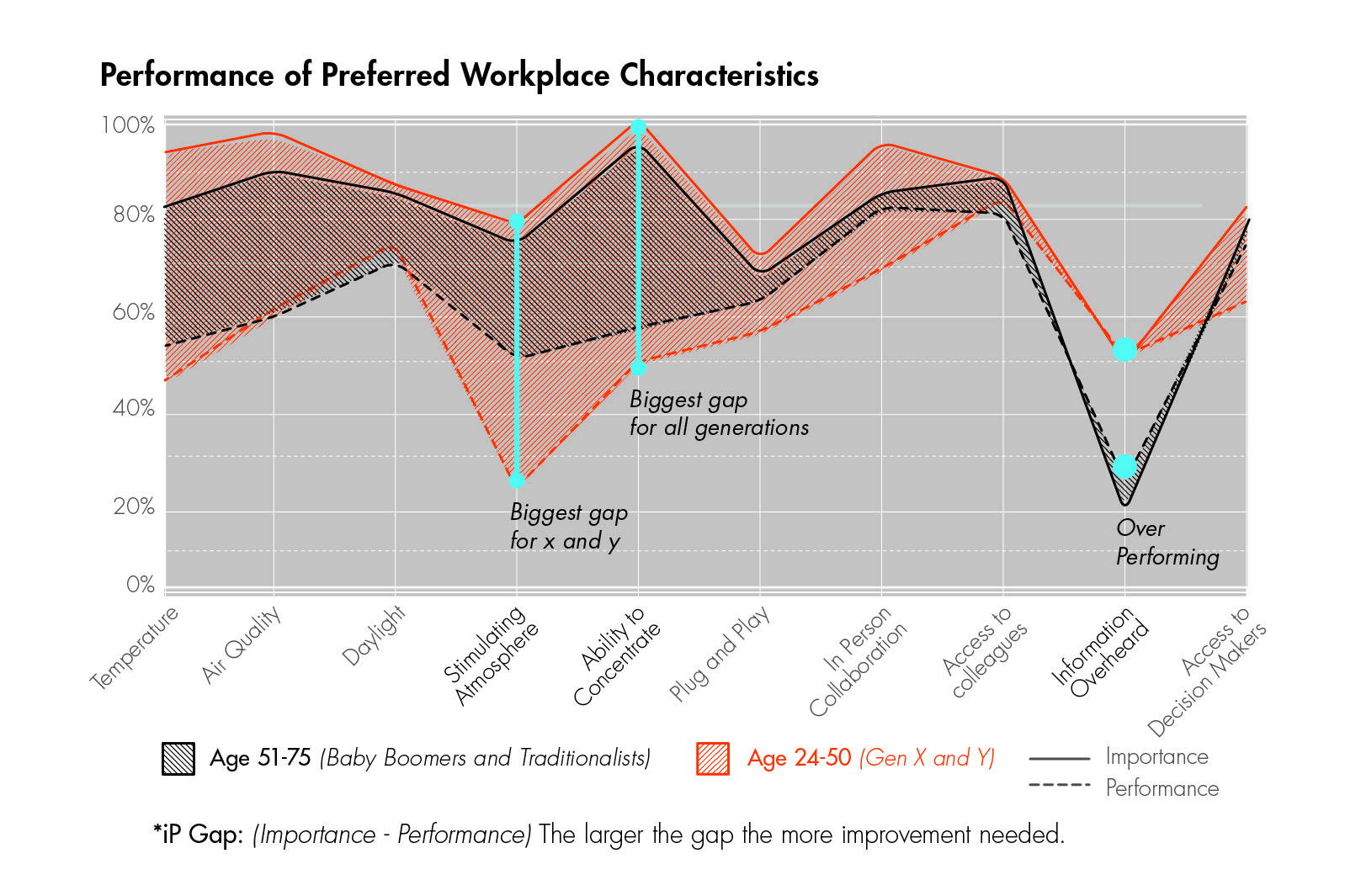Mancini•Duffy, a leading architectural and interiors firm, has released findings from The Coordinate, its periodic survey on workplace trends. The most recent survey indicates that less than one-quarter of the work performed in a single day requires a face-to-face interaction.
With the rise of technology, much of the workday—even the most productive morning hours—is spent corresponding via email or conference call.
The survey results also show that for employees, being able to work at times that are most productive and being able to have a choice of places to work is not a case of either/or, but of both/and.
“Employees want flexibility and choice,” said Fran Ferrone, Mancini•Duffy’s Director of Workplace Innovation.
Additional findings highlight:
• Gen X and Y’s biggest dissatisfaction is “lack of stimulating atmosphere."
• While concentration is a problem for all, it is less so for Boomers and Traditionalists, who occupy the majority of private offices.
• Despite the trend toward collaboration, all generations say “information overheard” is over-performing.
These findings are the second in a series of surveys being conducted by Mancini•Duffy this year to test the hypothesis of “the dissolution of the traditional workweek.” The next survey, addressing “sources of inspiration and motivation,” will round out the series.
Complete results (and their implications) will be published in early 2015. To participate in the Coordinate survey, visit: http://www.cvent.com/d/d4q2kp.
Contact CWI@manciniduffy.com for additional information or questions about The Coordinate.
About Mancini•Duffy
Mancini•Duffy is a full service design firm specializing in architecture, planning, interior design and graphic design services. Founded almost 100 years ago, the firm is headquartered in New York City. Also, as a member of IPID, International Partners in Design, Mancini•Duffy serves the diverse needs of its expanding multi-national client base across the U.S. and in Great Britain, Europe, East Asia and Australia. http://www.manciniduffy.com.
Related Stories
AEC Tech Innovation | Oct 8, 2024
New ABC technology report examines how AI can enhance efficiency, innovation
The latest annual technology report from Associated Builders and Contractors delves into how artificial intelligence can enhance efficiency and innovation in the construction sector. The report includes a resource guide, a case study, insight papers, and an essay concerning applied uses for AI planning, development, and execution.
Healthcare Facilities | Oct 8, 2024
Herzog & de Meuron completes Switzerland’s largest children’s hospital
The new University Children’s Hospital Zurich features 114 rooftop patient rooms designed like wooden cottages with their own roofs. The project also includes a research and teaching facility.
Mixed-Use | Oct 7, 2024
New mixed-use tower by Studio Gang completes first phase of San Francisco waterfront redevelopment
Construction was recently completed on Verde, a new mixed-use tower along the San Francisco waterfront, marking the end of the first phase of the Mission Rock development. Verde is the fourth and final building of phase one of the 28-acre project that will be constructed in several phases guided by design principles developed by a design cohort led by Studio Gang.
Brick and Masonry | Oct 7, 2024
A journey through masonry reclad litigation
This blog post by Walter P Moore's Mallory Buckley, RRO, PE, BECxP + CxA+BE, and Bob Hancock, MBA, JD, of Munsch Hardt Kopf & Harr PC, explains the importance of documentation, correspondence between parties, and supporting the claims for a Plaintiff-party, while facilitating continuous use of the facility, on construction litigation projects.
Glass and Glazing | Oct 7, 2024
Pattern language: An exploration of digital printing on architectural glazing
Architectural Glazing has long been an important expressive tool which, when selected and detailed thoughtfully, can contribute to the successful transformation of architectural concepts to reality.
University Buildings | Oct 4, 2024
Renovations are raising higher education campuses to modern standards
AEC higher ed Giants report working on a variety of building types, from performing arts centers and libraries to business schools. Hybrid learning is seemingly here to stay. And where possible, these projects address wellness and mental health concerns.
AEC Tech | Oct 3, 2024
4 ways AI impacts building design beyond dramatic imagery
Kristen Forward, Design Technology Futures Leader, NBBJ, shows four ways the firm is using AI to generate value for its clients.
Laboratories | Oct 2, 2024
Trends in scientific research environments: Q&A with Flad's Matt McCord
As part of an ongoing series, Matt McCord, AIA, NCARB, LEED AP BD+C, Associate Principal with Flad Architects, discusses the future of the scientific workplace.
Museums | Oct 1, 2024
UT Dallas opens Morphosis-designed Crow Museum of Asian Art
In Richardson, Tex., the University of Texas at Dallas has opened a second location for the Crow Museum of Asian Art—the first of multiple buildings that will be part of a 12-acre cultural district. When completed, the arts and performance complex, called the Edith and Peter O’Donnell Jr. Athenaeum, will include two museums, a performance hall and music building, a grand plaza, and a dedicated parking structure on the Richardson campus.
Data Centers | Oct 1, 2024
10 biggest impacts to the data center market in 2024–2025
While AI sends the data center market into the stratosphere, the sector’s accelerated growth remains impacted by speed-to-market demands, supply chain issues, and design innovation necessities.


















